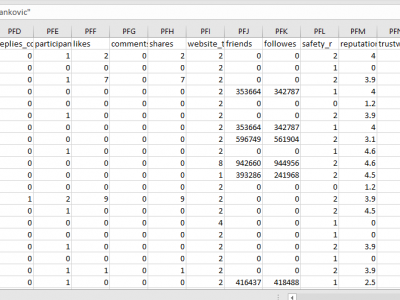Machine Learning

This dataset includes time-series motion data of a hexapod walked by CPGs.
Each trajectory has 500 steps of 18-dimensional observed joint angles and 18 reference joint angles as state; and six commands to CPGs as action.
150 trajectories for training, 25 trajectories for validation, and 25 trajectories for test are seperately summarized in the respective files.
- Categories:
 101 Views
101 Views
In Indian sub-continent COVID-19 second wave started in early March 2021 and its effect was more lethal than the first wave, the confirmed cases and the death rate was higher than in the first wave. Unlike the national lockdown in 2020, this year different states have started imposing lockdown like restrictions spanning April-June 2021. This paper investigates the sentiments of the people using twitter messages during early period of the second wave. Two-weeks data is manually annotated and several machine learning models were built.
- Categories:
 1360 Views
1360 Views(Work in progress)
This dataset contains the augmented images and the images & segmentation maps for seven handwashing steps, six of which are prescirbed WHO handwashing steps.
This work is based on a sample handwashing video dataset uploaded by Kaggle user real-timeAR.
- Categories:
 344 Views
344 Views
To improve the applicability and generalizability of ML/DL-related SE studies, we conducted a 12-year Systematic Literature Review (SLR) on 1,428 ML/DL-related SE papers published between 2009 and 2020. Our trend analysis demonstrated the impacts that ML/DL brought to SE. We examined the complexity of applying ML/DL solutions to SE problems and how such complexity led to issues concerning the reproducibility and replicability of ML/DL studies in SE.
- Categories:
 260 Views
260 Views
Owing to increased biosecurity and industrial demands, the poultry houses in Taiwan are generally nonopen and closed types, with automatic environmental control and sensor equipment gradually being installed in such houses. Environmental sensors and poultry health monitoring systems are necessary to improve poultry feeding efficiency and safety. In this work, we developed a goose surface temperature monitoring system based on deep learning using visible image and integrated with infrared thermal image.
- Categories:
 236 Views
236 Views
It is important for network operators to carry out traffic and application characterization to gain insights into the activity of their networks. Several studies proposed methods that extract features from network traffic to characterize it, or to classify the application that produced it, based on a ?man in the middle? network interception point that can analyze the entire network traffic of an organization.
- Categories:
 590 Views
590 ViewsThe network attacks are increasing both in frequency and intensity with the rapid growth of internet of things (IoT) devices. Recently, denial of service (DoS) and distributed denial of service (DDoS) attacks are reported as the most frequent attacks in IoT networks. The traditional security solutions like firewalls, intrusion detection systems, etc., are unable to detect the complex DoS and DDoS attacks since most of them filter the normal and attack traffic based upon the static predefined rules.
- Categories:
 8209 Views
8209 Views
Any work using this dataset should cite this paper as follows:
Nirmalya Thakur and Chia Y. Han, "Country-Specific Interests towards Fall Detection from 2004–2021: An Open Access Dataset and Research Questions", Journal of Data, Volume 6, Issue 8, pp. 1-21, 2021.
Abstract
- Categories:
 1971 Views
1971 ViewsThe Internet of things (IoT) has emerged as a topic of intense interest among the research and industrial community as it has had a revolutionary impact on human life. The rapid growth of IoT technology has revolutionized human life by inaugurating the concept of smart devices, smart healthcare, smart industry, smart city, smart grid, among others. IoT devices’ security has become a serious concern nowadays, especially for the healthcare domain, where recent attacks exposed damaging IoT security vulnerabilities. Traditional network security solutions are well established.
- Categories:
 13042 Views
13042 Views

